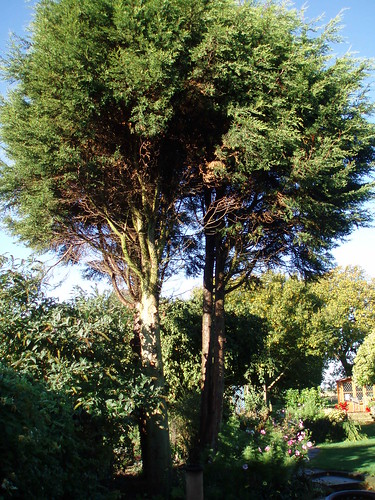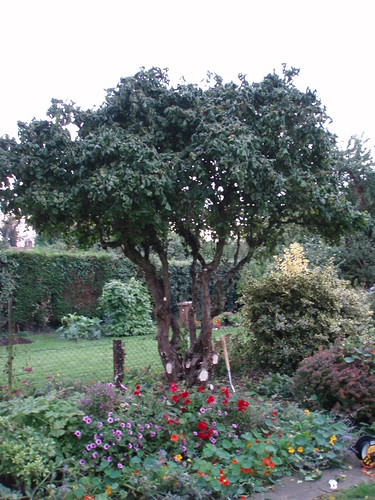 |
| Cross sections of the tulip tree trunk |
It was sad to see the tulip tree go. I had in mind that Janet and Andrew Knights had bought it for my 40th birthday, but when we cut it down I took some ring sections and could count only 14 or 15 rings which would have put me at 45 when the tree started out.
I’m not sure whether you can accurately date a tree’s age by the rings because it must have spent its first few years as a skinny shoot a centimetre across. I can remember Janet and Andrew bringing it around and putting it in our kitchen standing in its pot. It must have been no more than five feet high.
It was a very good present. Years before I’d read about the magnificent tulip tree avenue at Kew Gardens and what a wonderful sight it was when they flowered. Margaret and I had been to Kew about 35 years ago to try to see them, but had missed the flowers by a week. I must have told the story to Janet and Andrew, so they bought me the tree and I planted it in the garden - cue (or Kew) years of my own magnificent displays.
The tulip tree is so named not because its flowers look like tulips, it’s because its leaves have a distinct three-lobed shape, just like the traditional rendition of a tulip flower. It grew straight and strong and very quickly and, after a few years, I was able to discard the stake and tie. But although it was clearly thriving, there were no flowers. It became a standing joke to ask me if the tulip tree had flowered.
About 10 years ago, during the summer, the leaves on the tree started to get brown spots, turn yellow, die and drop off. They have always started off green and healthy and the tree continued to grow, but the new leaves that came out in May had all gone by late August and the tree looked decidedly shabby every summer. It must have some kind of fungal or viral infection and I might have tried to spray it, but spraying a 30-feet tree is not easy (or practical) so this year I took a look at it and decided it was best to go (there hasn’t been even a hint of a flower to compensate for the shabby leaves). To make matters worse, the Knights have bought a tulip tree of their own and despite being in their garden for just a few years, it flowered for the first time this year. Margaret went to see it, but I was at work and unable to, so I still haven’t seen a tulip tree in flower.
Well, my own tulip tree certainly won’t be flowering now. It was some 30 feet high, so we took it down in sections, lopping off as many lower branches as possible, putting a rope on the top section to pull it into our garden and then cutting the trunk halfway up. Once that was on the lawn, I took the bottom section down in the same way and then dug around the stump and cut that off as close to the ground as I could. The wood was very soft and wet compared to something like oak, so the chain saw went through it very easily. I split the bigger logs and we’ve laid them out to dry. They can go in the chiminea next summer.
Before chopping it up into chiminea-sized chunks, I noticed that the growth rings on the tree were very distinct and quite wide. I thought they might be good for Max to use in the classroom to illustrate tree growth and how the tree grows more one year than another. I cut two sections and stood them on their side on the table in the summerhouse for safe keeping. When we retired for “goutier” Margaret remarked what nice ornaments they made and they did look very nice. I should have cut a few more in hindsight, but they might split and crack as they dry out - like I said, tulip tree wood is quite soft and wet.
We got the chipper on the lawn and while I was getting through the big logs, Margaret chipped all the smaller branches and spread the chippings in the compost bin and around the garden. It was as if the tree had never been there, we’d been industrial in our destruction and processing. I’m always sorry to see a tree go, but the garden does look better without it; it was not an attractive tree and the bottom of the garden is a lot more light. I now have to think of what we’ll do with that border.
 |
| Pruned leylandii |
The problem with topping a leylandii is that you think you’ve stopped it growing any taller. What actually happens is the main shoot is stopped, but a dozen side branches grow and take up the race for the sky. My plan was to get a ladder up to the original cut-off point and then prune (cut off) all the second branches. Margaret was deeply unhappy with this plan, mainly concerned about my safety but also a bit worried that the trees would look as if they’d been given a flat-top haircut. My reassurances that they would grow again and look fine in a year or two were not helping.
I put a ladder up and climbed to the first cut. It was a lot higher than I thought and the prospect of climbing into the tree, with a chainsaw and stretching to lop branches was not inviting. Health & Safety would have had kittens. I decided on a different approach. After quite some time spent walking around the trees and staring up into the tops, we decided that removing a few more lower branches would do the trick. Margaret was not convinced and argued for every branch’s life until it was cut away and then agreed that it did look better without it. We removed about 10 branches and by then Margaret had the tree chopper’s equivalent of blood lust - I’ll call it sap-lust - and wanted more pruning. She had her eye on two odd branches sticking out at right angles, but they were quite small and difficult to reach so their lives were spared.
We had done quite a good job, but there was a pile of branches on the lawn for processing. Whenever I prune the leylandii, I’m staggered by how much foliage there is. The size and weight of some of the higher branches was really surprising, we’ve probably taken down around 250kg from the tops and there’s more light coming through without spoiling the overall shape. There was only a couple of hours left in the day, so we made a start on clearing the branches. The smaller pieces would be chipped, the bigger ones saved for firewood and the green leaves spread around the garden by the summerhouse to die down and mulch. Margaret was in charge of chipping and spreading, I was the sorter and processor. Actually by 4.30pm, we were both pretty weary and decided to clear up and get some fish and chips from Eye.
Friday was supposed to be rain in the morning but bright in the afternoon so we thought we’d get finished then. Actually, it rained all night and the following day was quite cold and grey, so that the lawn remained sodden. If we’d worked on that we’d have really chewed up the turf, so best to stay off it. We went to Whittlesey, I made a loaf of bread, some flapjack and a parkin loaf. It rained again in the evening.
Saturday was bright and clear however, although the lawn was still very wet in the morning. I took the dogs for a long walk across the fen and it was very pleasant - one of those clear, crisp autumn days. Holly had a good sweep of the fields that have been left fallow and the walk turned out to be longer than expected while Gravel and I had to wait for her to show up. She did, in the end, like she always does but when I’d walked another quarter of a mile, I realised I’d lost her again. She’d obviously scented something interesting and had doubled back for another session. I called her - nothing; waited, then called again - nothing. So Gravel and I retraced our steps for a few hundred yards then Holly could be seen in the distance heading towards us on the path. I turned round and walked towards home pretty briskly to give her a challenge to overtake. She wasn’t done then, there was still time to shoot off down another track/dyke this time with Gravel leading the way. Springers can’t resist a scent and if their nose is working their ears stop completely. Gravel is now much better at staying close, but even he disappears quite often. You just have to trust them; they always come back and they can’t get up to too much trouble surrounded by miles of arable land!
We have a pre-arranged point where their leads go back on and they always get a biscuit, so recall suddenly becomes very good. In fact, Holly is often sat waiting near the leads-on point. There wasn’t much wildlife to see today, but I did see one lone house martin skimming the fields. He was flying south and I guess he was going a bit further than Whittlesey.
 |
| My growing woodpile - got enough for next summer |
 |
| A wheelbarrow full of twisted logs and sticks from the corkscrew hazel |
On Saturday evening, we celebrated with a couple of G&Ts on the patio while the sun went down. I lit the chiminea and we sat out until dark. It was a lovely evening, with no wind and a clear night. The bat was still hunting for insects, hopefully getting enough to hibernate successfully.
Today was another lovely day. Margaret and I walked the dogs and had breakfast when we got home. Today’s job was more pruning - this time it was the corkscrew hazel. We’ve transformed it this year - Margaret spent some time getting all the ivy off it about a month ago and today we removed all the suckers and various crossing branches so we could open up the inside of the tree. The chainsaw is a wonderful tool, it makes lopping and cutting so easy.
We took loads of wood out and it was really hard work. There was so much wood to process that we didn’t quite get it finished and the wood store will be overflowing with logs and sticks for next year. The big border is now quite open all the way down - I’m going to have to give some serious thought to what we do next year.
 |
| Well and truly pruned - the corkscrew hazel |
Footnote: Margaret managed to clear the last bits of hazel during the week and this weekend, we moved the woodpile (so the oldest was at the front) and I took the chainsaw to the rest. We now have a very respectable pile of wood for next year's chiminea burning.
No comments:
Post a Comment